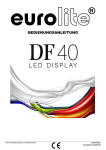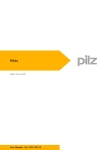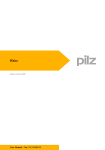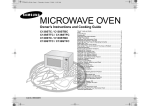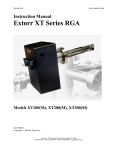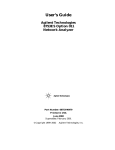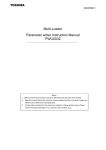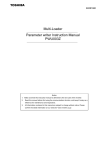Download USER MANUAL - LTT
Transcript
USER MANUAL KEEP THIS MANUAL FOR FUTURE NEEDS © COPYRIGHT REPRODUCTION PROHIBITED TABLE OF CONTENTS INTRODUCTION ............................................................................................................................................... 3 SAFETY INSTRUCTIONS ................................................................................................................................ 4 OPERATING DETERMINATIONS.................................................................................................................... 6 COMPONENTS OF A DISPLAY....................................................................................................................... 7 >> Control Systems ........................................................................................................................................ 7 >> Mounting Elements and Connections of a Display.................................................................................... 9 >> Control System with Control Software PC Studio ................................................................................... 10 >> Operating Elements and Connections of the Control Unit....................................................................... 10 >> Media Player with Control Software SD Studio ....................................................................................... 11 >> Operating Elements and Connections of the Media Player .................................................................... 11 INSTALLATION .............................................................................................................................................. 13 CONNECTIONS .............................................................................................................................................. 14 >> PC Operation ........................................................................................................................................... 14 >> Media Player Operation........................................................................................................................... 16 Connection to the Mains .............................................................................................................................. 17 PC STUDIO ..................................................................................................................................................... 18 >> Example Configuration ............................................................................................................................ 18 >> PC Operation with the Control Software PC Studio ................................................................................ 19 Installation .................................................................................................................................................... 19 File Types..................................................................................................................................................... 19 Graphical User Interface .............................................................................................................................. 20 Toolbar ......................................................................................................................................................... 20 Editor............................................................................................................................................................ 20 Configuration................................................................................................................................................ 21 Monitor Settings ........................................................................................................................................... 21 Display Settings ........................................................................................................................................... 22 Storing User Settings ................................................................................................................................... 26 Function Test ............................................................................................................................................... 27 Play Window Adjustments ........................................................................................................................... 27 >> First Steps to a Show with PC Studio...................................................................................................... 28 Program Types............................................................................................................................................. 28 Creating a Show and Loading Video ........................................................................................................... 29 Storing Your Show ....................................................................................................................................... 31 Playing Your Show....................................................................................................................................... 31 SD STUDIO ..................................................................................................................................................... 32 >> Media Player Operation with the Control Software SD Studio ................................................................ 32 Installation .................................................................................................................................................... 32 File Types..................................................................................................................................................... 32 Graphical User Interface .............................................................................................................................. 33 Toolbar ......................................................................................................................................................... 33 Configuration................................................................................................................................................ 34 Display Settings ........................................................................................................................................... 35 Storing User Settings ................................................................................................................................... 39 >> First Steps to a Show with SD Studio...................................................................................................... 40 Creating a Show and Loading Video ........................................................................................................... 40 Video Capture .............................................................................................................................................. 42 Live Video Capture ...................................................................................................................................... 43 Video File Capture ....................................................................................................................................... 44 Checking and Editing ................................................................................................................................... 45 Storing Your Video ....................................................................................................................................... 45 Storing Your Show ....................................................................................................................................... 46 Exporting Your Show Onto the SD Card ..................................................................................................... 47 >> Playing Shows with the Media Player ..................................................................................................... 48 Brightness, Speed, Color, Data Transmission and Play Mode Adjustment................................................. 48 CLEANING AND MAINTENANCE ................................................................................................................. 49 PROBLEM CHART ......................................................................................................................................... 50 TECHNICAL SPECIFICATIONS..................................................................................................................... 51 This user manual is valid for the article numbers: 80503600, 80503610, 80503615, 80503620 2/51 00066923.DOC, Version 1.0 1 INTRODUCTION DF-40 LED-DISPLAY .............................................................................................................................................................................. CAUTION! Keep this device away from rain and moisture! Unplug mains lead before opening the housing! For your own safety, please read this user manual carefully before you initially start-up. You can find the latest update of this user manual in the Internet under: www.eurolite.de Every person involved with the installation, operation and maintenance of this device has to - be qualified - follow the instructions of this manual - consider this manual to be part of the total product - keep this manual for the entire service life of the product - pass this manual on to every further owner or user of the product - download the latest version of the user manual from the Internet Thank you for having chosen a EUROLITE LED display. If you follow the instructions given in this manual, we are sure that you will enjoy this device for a long period of time. .............................................................................................................................................................................. 3/51 00066923.DOC, Version 1.0 2 SAFETY INSTRUCTIONS da CAUTION! Be careful with your operations. With a dangerous voltage you can suffer a dangerous electric shock when touching the wires! This device has left our premises in absolutely perfect condition. In order to maintain this condition and to ensure a safe operation, it is absolutely necessary for the user to follow the safety instructions and warning notes written in this user manual. Important: Damages caused by the disregard of this user manual are not subject to warranty. The dealer will not accept liability for any resulting defects or problems. If the device has been exposed to drastic temperature fluctuation (e.g. after transportation), do not switch it on immediately. The arising condensation water might damage your device. Leave the device switched off until it has reached room temperature. Please make sure that there are no obvious transport damages. Should you notice any damages on the A/C connection cable or on the casing, do not take the device into operation and immediately consult your local dealer. The LED display falls under protection-class III. The device must be operated with an appropriate power unit. The DF control system, DF media player and the power unit fall under protection-class I. The power plug must only be plugged into a protection class I outlet. The voltage and frequency must exactly be the same as stated on the device. Wrong voltages or power outlets can lead to the destruction of the device and to mortal electrical shock. Always plug in the power plug last. The power plug must always be inserted without force. Make sure that the plug is tightly connected with the outlet. Never let the power-cord come into contact with other cables! Handle the power-cord and all connections with the mains with particular caution! Never touch them with wet hands, as this could lead to mortal electrical shock. Never modify, bend, strain mechanically, put pressure on, pull or heat up the power cord. Never operate next to sources of heat or cold. Disregard can lead to power cord damages, fire or mortal electrical shock. The cable insert or the female part in the device must never be strained. There must always be sufficient cable to the device. Otherwise, the cable may be damaged which may lead to mortal damage. Make sure that the power-cord is never crimped or damaged by sharp edges. Check the device and the power-cord from time to time. If extension cords are used, make sure that the core diameter is sufficient for the required power consumption of the device. All warnings concerning the power cords are also valid for possible extension cords. Always disconnect from the mains, when the device is not in use or before cleaning it. Only handle the power-cord by the plug. Never pull out the plug by tugging the power-cord. Otherwise, the cable or plug can be damaged leading to mortal electrical shock. If the power plug or the power switch is not accessible, the device must be disconnected via the mains. If the power plug or the device is dusty, the device must be taken out of operation, disconnected and then be cleaned with a dry cloth. Dust can reduce the insulation which may lead to mortal electrical shock. More severe dirt in and at the device should only be removed by a specialist. 4/51 00066923.DOC, Version 1.0 There must never enter any liquid into power outlets, extension cords or any holes in the housing of the device. If you suppose that also a minimal amount of liquid may have entered the device, it must immediately be disconnected. This is also valid, if the device was exposed to high humidity. Also if the device is still running, the device must be checked by a specialist if the liquid has reduced any insulation. Reduced insulation can cause mortal electrical shock. There must never be any objects entering into the device. This is especially valid for metal parts. If any metal parts like staples or coarse metal chips enter into the device, the device must be taken out of operation and disconnected immediately. Malfunction or short-circuits caused by metal parts may cause mortal injuries. HEALTH HAZARD! Never look directly into the light source, as sensitive persons may suffer an epileptic shock (especially meant for epileptics)! Keep away children and amateurs! Never leave this device running unattended. .............................................................................................................................................................................. 5/51 00066923.DOC, Version 1.0 3 OPERATING DETERMINATIONS The DF-40 is a flexible display equipped with bright tri-color RGB LEDs. It was specially designed for projection of videos and graphics synchronous to the computer or the DF media player. The display bends, rolls and moulds around almost any shape for waves, columns, circles, arcs and angles. The modular design allows the horizontal and vertical built-up of indoor video screens. Control is via special PC software with the DF control system and the DF media player (optional). The display requires an operating voltage of 5 V direct current, supplied by the optional matching power unit. A separate power unit is needed for each display. The power unit, the DF control system and the DF media player are allowed to be operated with an alternating voltage of 100-240 V AC, 50/60 Hz. All products were designed for indoor use only. The ambient temperature must always be between -10° C and +45° C. Keep away from direct insulation (particularly in cars) and heaters. The maximum relative humidity is 100 % with an ambient temperature of 25° C. This device must only be operated in an altitude between -20 and 2000 m over NN. Do not shake the device. Avoid brute force when installing or operating the device. When choosing the installation spot, please make sure that the device is not exposed to extreme heat, moisture or dust. There should not be any cables lying around. You endanger your own and the safety of others! Make sure the area below the installation place is cordoned off when mounting or servicing the device. The F-symbol means: this device can be installed on normal inflammable surfaces. - - -m The symbol determines the minimum distance from lighted objects. The minimum distance between light output and the illuminated surface must be more than the given value. The maximum ambient temperature Ta= 45° C must never be exceeded. Never use solvents or aggressive detergents in order to clean the device! Rather use a soft and damp cloth. Please consider that unauthorized modifications on the device are forbidden due to safety reasons! If this device will be operated in any way different to the one described in this manual, the product may suffer damages and the guarantee becomes void. Furthermore, any other operation may lead to dangers like shortcircuit, burns, electric shock, lamp explosion, etc. .............................................................................................................................................................................. 6/51 00066923.DOC, Version 1.0 4 COMPONENTS OF A DISPLAY The following describes all components needed to operate a DF-40 LED display. .............................................................................................................................................................................. >> Control Systems Possible number of displays Resolution Minimum 1 display 22 x 22 pixels Maximum 6 displays with 1 control unit e.g. 22 x 132 pixels Maximum 1530 displays with 255 control units e.g. 33600 x 33600 pixels .............................................................................................................................................................................. 7/51 00066923.DOC, Version 1.0 .............................................................................................................................................................................. Possible number of displays Resolution Minimum 1 display Maximum 6 displays with 1 control unit Maximum 288 displays/48 control units with 1 media player Second video wall with identical picture with 1 media player 22 x 22 pixels e.g. 22 x 132 pixels e.g. 6336 x 6336 pixels e.g. 6336 x 6336 pixels .............................................................................................................................................................................. 8/51 00066923.DOC, Version 1.0 .............................................................................................................................................................................. >> Mounting Elements and Connections of a Display .............................................................................................................................................................................. 9/51 00066923.DOC, Version 1.0 .............................................................................................................................................................................. >> Control System with Control Software PC Studio The control system consists of a control unit and the light effect software [PC Studio] and allows for control of DF displays together with a computer with Windows operating system and network card. Configuration, setting of control functions and design of light shows is done with the software. The data is transmitted from the computer to the control unit via the included patch cable. If needed, a longer standard CAT5e patch cable may be used. A control units connects a maximum of six DF displays in series. To built-up a large video wall up to 255 control units can be connected in series using patch cables. .............................................................................................................................................................................. >> Operating Elements and Connections of the Control Unit .............................................................................................................................................................................. 10/51 00066923.DOC, Version 1.0 .............................................................................................................................................................................. >> Media Player with Control Software SD Studio Using the media player and the light effect software [SD Studio] the displays can be operated in stand-alone mode without a computer after the basic configuration. This makes the system perfect for rental use and mobile applications. The configuration, setting of control functions and design of light shows is similar to the computer operating mode. All user settings and data are then loaded on to the included SD memory card for playback on the media player. As with the computer operating mode, data transmission to the displays is done via control units. The media player offers two ethernet outputs for this purpose. Up to 48 control units can be connected in series on any of the two outputs. This corresponds to a total number of 258 displays. If necessary, the second output can be used for a second video wall displaying the same image. .............................................................................................................................................................................. >> Operating Elements and Connections of the Media Player .............................................................................................................................................................................. 11/51 00066923.DOC, Version 1.0 .............................................................................................................................................................................. .............................................................................................................................................................................. 12/51 00066923.DOC, Version 1.0 5 INSTALLATION Attach the displays at your desired location using the included fixation strips. Alternatively you can e.g. affix hook bands to the rear. Caution! For installation in public or industrial areas, a series of safety instructions have to be followed that this manual can only give in part. The operator must therefore inform himself on the current safety instructions and consider them. The manufacturer cannot be made liable for damages caused by incorrect installations or insufficient safety precautions! DANGER TO LIFE! Please consider the EN 60598-2-17and the respective national standards during the installation! The installation must only be carried out by an authorized dealer! The device has to be installed out of the reach of people and should be installed outside areas where persons may walk by or be seated. The installation area for the display has to be built and constructed in a way that it can hold 4 times the weight for 1 hour without any harming deformation. DANGER OF FIRE! When installing the device, make sure there is no highly-inflammable material (decoration articles, etc.) within a distance of min. 0.5 m. The operator has to make sure that safety-relating and machine-technical installations are approved • by an expert before taking into operation for the first time and after changes before taking into operation another time. • by an expert after every four year in the course of an acceptance test. • by a skilled person once a year. IMPORTANT! Overhead rigging requires extensive experience, including (but not limited to) calculating working load limits, installation material being used, and periodic safety inspection of all installation material and the device. If you lack these qualifications, do not attempt the installation yourself, but instead use a professional structural rigger. Improper installation can result in bodily injury and or damage to property. DANGER TO LIFE! Before taking into operation for the first time, the installation has to be approved by an expert! .............................................................................................................................................................................. 13/51 00066923.DOC, Version 1.0 6 CONNECTIONS >> >> >> Only use patch cables type CAT5e or better between network card and control unit. Do not use a network hub or switch or any other network extension to connect the control unit to the computer. Do not bent or apply tension to the display's data cables and the power cable to prevent damage. .............................................................................................................................................................................. >> PC Operation .............................................................................................................................................................................. Connecting the control unit Connect the data signal input [Ethernet IN] (right jack) of the control unit to the ethernet port (RJ45 jack) of the computer via the included patch cable. The control unit's output [Ethernet OUT] (left jack) serves for relaying the data signal to the input [Ethernet IN] on the next control unit. A maximum of 255 control units can be connected in series. If needed, a standard CAT5e patch cable up to 100 meters long may be used (point-to-point connection provided). Different lengths are available as accessory. .............................................................................................................................................................................. 14/51 00066923.DOC, Version 1.0 .............................................................................................................................................................................. Connecting the displays Connect the control unit to the first display in the chain as shown. For this purpose, connect the control unit's data cable [PORT 1] to the display's data cable. If needed, extension cables may be used. 1 and 3 meter cables are available as accessory. The other data cable on the display serves for relaying the data signal to a subsequent display. A control unit connects up to 6 displays in series. The connectors are equipped with a lock which is released by pressing the lever down. This user manual describes the data flow from left to right. Cabling can also be made differently. When configuring the software later on, the order of the displays and the control units must be specified. .............................................................................................................................................................................. 15/51 00066923.DOC, Version 1.0 .............................................................................................................................................................................. >> Media Player Operation .............................................................................................................................................................................. Connecting the displays and the control unit Make the connections as described under PC operation. For media player operation, a maximum of 48 control units can be connected in series. Connecting the media player Connect the media player to the control unit. For this purpose, connect one of the data signal outputs [Ethernet OUT 1/2] of the media player to the data signal input [Ethernet IN] (right jack) of the control unit. Both data signal outputs of the media player can be used as desired. If necessary, the second output can be used for a second video wall displaying the same image. .............................................................................................................................................................................. 16/51 00066923.DOC, Version 1.0 .............................................................................................................................................................................. Connection to the Mains DANGER OF LIFE! Installation of the power supply units by skilled personnel only. After having connected all components, connect each display to a power supply unit. Then connect the power supply units to a mains outlet. >> Caution excessive heat built-up! Do not connect displays to the mains while they are folded and do operate them at full brightness over an extended period (brightness adjustment is part of the configuration later on). Connect the control units to a mains outlet. The power indicator [PWR] lights up Connect the media player to a mains outlet. >> Caution! Make sure an SD card is inserted in the media player prior to switching on the unit. Otherwise the media player may be irreparably damaged. After operation, disconnect the displays from the mains via their power supply units and then loosen all cable connections. All components can be operated with 100-240 V AC, 50/60 Hz ~. .............................................................................................................................................................................. 17/51 00066923.DOC, Version 1.0 7 PC STUDIO CONTROL SOFTWARE Depending on the operating mode, the matching PC program must be installed before taking the displays into operation. Both programs were designed as graphical user interface for use with the control unit and the media player. They allow for configuration, setting of control functions and design of light shows. The programs support all popular media formats, such as the video formats *.avi, *.swf, *.rm, *.mpeg, *.mpg, the image formats *.jpg, *.gif, *.bmp and the document formats *.txt, *.doc, *.excel, *.rtf. If there are speakers connected to your computer, you can optimally playback the audio part of videos or play background music. The program supports the audio formats *.mp3, *.midi, *.mid, *.wma, *.wav, *.snd and *.au. >> As drivers and software are constantly being developed, your installation screens and procedures may vary slightly from those described in this user manual. .............................................................................................................................................................................. >> Example Configuration As a reference, this user manual describes the configuration of a video wall of 6 x 3 meters. The setup requires 3 control units and 18 displays and corresponds to a resolution of 132 x 66 pixels. .............................................................................................................................................................................. 18/51 00066923.DOC, Version 1.0 .............................................................................................................................................................................. >> PC Operation with the Control Software PC Studio >> Caution! Use a separate network card for operating the control system [PC Studio]. .............................................................................................................................................................................. Installation Connect the displays as described before and connect the first control unit in the chain to your computer. As soon as an ethernet connection is established, the computer displays a dialog window in the lower right corner of the screen (possibly limited connectivity is displayed, nevertheless, the ethernet connection is sufficient for operation). The signal indicator [SIG] on the control unit will light up once the data link has been established. Now install the control software [PC Studio] on your computer. For this purpose, start the installation program on the supplied DVD and follow the instructions of the installation program. In order to install the control software you must log on to your computer as administrator or user with administrator rights. .............................................................................................................................................................................. File Types The control system [PC Studio] uses two different types of files. The following table lists both types and their function. PC Studio *.scu Stores the configuration settings (size, color, brightness, etc.) of the displays. *.act Contains a complete light show with all parameters adjusted. Please note that this file does not contain embedded files such as videos, pictures or text files. .............................................................................................................................................................................. 19/51 00066923.DOC, Version 1.0 .............................................................................................................................................................................. Graphical User Interface .............................................................................................................................................................................. Toolbar .............................................................................................................................................................................. Editor .............................................................................................................................................................................. 20/51 00066923.DOC, Version 1.0 .............................................................................................................................................................................. Configuration The control software must be configured for use with the displays and the control units. All settings can be stored and loaded at any later stage. Start the program. The graphical user interface and the start tab will be displayed. .............................................................................................................................................................................. Monitor Settings Call menu item [Setting] [System Setting] to start the configuration. In the [Software Setting] tab, enter the start position for the play window [Play window] on the computer monitor in fields [StartX] and [StartY]. Then specify the size in pixels: enter width and height in the corresponding fields. Our example requires [132 x 66]. The position and size of the play window changes accordingly. >> Note The size of the play window should correspond to the displays. Otherwise there will only be image output on parts of the video wall. 21/51 00066923.DOC, Version 1.0 You can make basic settings for the program by checking the corresponding option: [Start when windows starts up] starts the program automatically when Windows is started [Load file when starting] loads last light show (*.act file) when the program is started [Play document when starts up] loads and plays last light show (*.act file) when the program is started [Auto check version of software] automatic check of the software version [Exit does not turn off LED display] exiting the program does not turn off displays [Shutdown Timing] sets a shut-off timer In the [Bright/Color Settings] tab you can adjust the brightness and colors for the displays. This can also be done at any later stage. .............................................................................................................................................................................. Display Settings Call menu item [Setting] [Setting Sculpt] to start the configuration. A query dialog window for password entry is displayed. In the factory settings there is no password stored. Click [Ok] to continue. • If needed, you can specify a password with [Modify]. The edit window [Setting Sculpt Window] is displayed. This is where your settings for the displays are being made. .............................................................................................................................................................................. 22/51 00066923.DOC, Version 1.0 .............................................................................................................................................................................. Call menu item [File] [New] or click [ ] in the toolbar. In the [Create Sculpt] window, specify the size of the complete video wall in pixels: Enter width and height in the corresponding fields. Our example requires [132 x 66]. Then select [Plane] under [Sculpt]. .............................................................................................................................................................................. 23/51 00066923.DOC, Version 1.0 .............................................................................................................................................................................. Select [Return Col] for [Connection Mode]. If you are not in edit mode, call menu item [Edit] [Add] or click [ ] in the toolbar. Each individual pixel of the displays must be assigned to the control units. For this, pixels must be marked according to the cabling. This is done by dragging a window using the mouse. The control units will be displayed one below the other with different colors in field [No.]. The adjacent field [Count] will give you the number of pixels of the corresponding control unit. The cursor position is indicated in the lower center of the program. The window's width x height is displayed to the right. For our example configuration with 3 control units and 18 displays we need to drag 3 windows with 132 x 22 pixels each. Start with the first control unit by clicking position [1] in field [No.]. Based on the left to right cabling method, drag a window from the lower left side to the upper right side. For better orientation, use the indication of the cursor position. Start at position [X:1, Y:22] and stop at [X:132, Y:1]. The pixels marked will be displayed in red. The indication in field [Count] changes to [2904] pixels. Repeat the procedure for the second control unit. Click position [2] in field [No.] and drag a window from position [X:1, Y:44] to [X:132, Y:23]. The pixels marked will be displayed in green. 24/51 00066923.DOC, Version 1.0 Repeat the procedure a last time for the third control unit. Click position [3] in field [No.] and drag a window from position [X:1, Y:66] to [X:132, Y:45]. The pixels marked will be displayed in blue. Use the commands in the toolbar to correct steps. .............................................................................................................................................................................. Call menu item [Setting] [Slave Setting]. The [Slave Setting] window is displayed. Make the following adjustments in the [Slave Setting] window: [Light Type] [BGR] [Clock Rate] [1.00 MHz] [Gray Level] [16384] [Port Number] [1] [Bright] [<40] >> Caution! Do not set the value for brightness [Bright] above [40]. Otherwise the displays may be damaged due to excessive heat built-up. Click [Apply] to apply your settings. Finally, click [Ok]. .............................................................................................................................................................................. 25/51 00066923.DOC, Version 1.0 .............................................................................................................................................................................. Storing User Settings Call menu item [File] [Save] or click [ ] in the toolbar. Store your personal settings as *.scu file. ] in the toolbar to exit the edit window [Setting Sculpt Call menu item [File] [Return] or [ Window] and return to the standard interface. .............................................................................................................................................................................. 26/51 00066923.DOC, Version 1.0 .............................................................................................................................................................................. Function Test For various function tests, select menu item [Test]. .............................................................................................................................................................................. Play Window Adjustments Settings for the play window can be adjusted under menu item [Setting] [Play window setting] by checking the corresponding option: [Top display] The play window cannot be covered by other programs. [Show/Hide Play window] Shows/hides the play window. [Play window translucency] The play window becomes transparent which makes the underlying content visible on your displays as well. This option is mandatory for the lighting control software [MADRIX]. [Lock Play window] The play window is locked and cannot be dragged by the mouse. .............................................................................................................................................................................. 27/51 00066923.DOC, Version 1.0 .............................................................................................................................................................................. >> First Steps to a Show with PC Studio You can project e.g. videos and graphics in all popular formats on your displays. Some example files come with the supplied DVD. Furthermore, it is possible to display websites, embed audio files and create shows using the program's editors. .............................................................................................................................................................................. Program Types A show can consist of a variety of contents in the form of programs. There are 7 types available for these programs: File window For videos, images, texts, tables Text window Editor for short texts (one or more lines) Video window Video signal of external devices (webcam, TV...) Date/time window Date and time Time window Time Web window Websites (YouTube, Facebook, Twitter...) Design window Effect editor Depending on the type, several parameters such as background, position, text, play time and effects are adjustable. For each file type, create a new program window. This window can extend over the entire video wall or just a section. The [Web window] type is special. Here, the program window changes into an internet browser which can be operated with the mouse just like a regular browser tab. Example with the types [Web window], [Text window] and [Date/time window] .............................................................................................................................................................................. 28/51 00066923.DOC, Version 1.0 .............................................................................................................................................................................. Creating a Show and Loading Video First create a new program by clicking [ ]. The tree structure indicates [Program]. In the right [Program] tab you can adjust various parameters such as name, play time, background and the picture mode. >> Tip Load a background image for breaks during your show without a video. Hence your video wall will always display an image instead of going black. In addition to images you can embed audio files with [Background music Add]. The program supports the audio formats *.mp3, *.midi, *.mid, *.wma, *.wav, *.snd and *.au. . >> Tip Connect speakers to your computer to get ideal audio sound. .............................................................................................................................................................................. 29/51 00066923.DOC, Version 1.0 .............................................................................................................................................................................. Click the [ ] symbol to create a new program window. To play a video file from the included DVD select [File window]. A new window is displayed: [Open]. Navigate to the desired file and click [Open]. In the [Window] tab enter the start position for the program window in the fields [StartX] and [StartY]. Also enter width and height in the corresponding fields. • If needed, you can adjust further parameters such as name, frame and image mode. • If you check [Lock], the program window is locked and cannot be dragged with the mouse. The [File] tab indicates the file name, file path and the play time. • If needed, you can shorten the play time and adjust a number of repeats. Create further programs in the same way for your show. If there is more than one program, they will be played one after the other. .............................................................................................................................................................................. 30/51 00066923.DOC, Version 1.0 .............................................................................................................................................................................. Storing Your Show Call menu item [File] [Save] or click [ Use the option [Open] or the [ ] in the toolbar to store your show as *.act file. ] symbol in the toolbar to load the show later on. You can also have the last show automatically loaded or loaded and played at each program start page 22. .............................................................................................................................................................................. Playing Your Show Call menu item [Control] [Play] or click [ ] in the toolbar. • The editor tools will be closed and a smaller version of the program is displayed. • The video is displayed in the play window on your computer monitor and synchronously on the displays. Click [ ] for pause. Press [ ] to stop the show. .............................................................................................................................................................................. 31/51 00066923.DOC, Version 1.0 8 SD STUDIO CONTROL SOFTWARE >> Media Player Operation with the Control Software SD Studio Installation Install the control software [SD Studio] on your computer. For this purpose, start the installation program on the supplied DVD and follow the instructions of the installation program. In order to install the control software you must log on to your computer as administrator or user with administrator rights. .............................................................................................................................................................................. File Types The control system [SD Studio] uses different types of files. The following table lists all types and their function. SD Studio *.scu Stores the configuration settings (size, color, brightness, etc.) of the displays. *.map Backup copy of the *.scu file *.vid • Contains the complete light show with all parameters adjusted. This file does not contain embedded files such as videos, pictures or text files. • Captured video file *.dat Export file for the SD memory card. Contains the complete light show with all parameters adjusted and all embedded files such as videos, pictures or text file. .............................................................................................................................................................................. 32/51 00066923.DOC, Version 1.0 .............................................................................................................................................................................. Graphical User Interface .............................................................................................................................................................................. Toolbar .............................................................................................................................................................................. 33/51 00066923.DOC, Version 1.0 .............................................................................................................................................................................. Configuration The control software must be configured for use with the displays and the control units. All settings can be stored and loaded at any later stage. Start the program. When starting the program a dialog requesting the user settings [*.scu file] is displayed. Ignore this point during your initial configuration and click [Cancel]. • Later you can load your settings at this point. • After the query dialog, the standard user interface is opened. .............................................................................................................................................................................. 34/51 00066923.DOC, Version 1.0 .............................................................................................................................................................................. Display Settings Call menu item [Setting] [Setting Sculpt] to start the configuration. A dialog requesting the user settings [*.scu file] is displayed. Ignore this point during your initial configuration and click [Cancel]. • Later you can load your settings at this point. The edit window [Setting Sculpt Window] is displayed. This is where your settings for the displays are being made. • This part is similar to the control software [PC Studio]. .............................................................................................................................................................................. 35/51 00066923.DOC, Version 1.0 .............................................................................................................................................................................. Call menu item [File] [New] or click [ ] in the toolbar. In the [Create Sculpt] window, specify the size of the complete video wall in pixels: Enter width and height in the corresponding fields. Our example requires [132 x 66] pixels. Then select [Plane] under [Sculpt]. .............................................................................................................................................................................. 36/51 00066923.DOC, Version 1.0 .............................................................................................................................................................................. Select [Return Col] for [Connection Mode]. If you are not in edit mode, call menu item [Edit] [Add] or click [ ] in the toolbar. Each individual pixel of the displays must be assigned to the control units. For this, pixels must be marked according to the cabling. This is done by dragging a window using the mouse. The control units will be displayed one below the other with different colors in field [No.]. The adjacent field [Count] will give you the number of pixels of the corresponding control unit. The cursor position is indicated in the lower center of the monitor. The window's width x height is displayed to the right. For our example configuration with 3 control units and 18 displays we need to drag 3 windows with 132 x 22 pixels each. Start with the first control unit by clicking position [1] in field [No.]. Based on the left to right cabling method, drag a window from the lower left side to the upper right side. For better orientation, use the indication of the cursor position. Start at position [X:1, Y:22] and stop at [X:132, Y:1]. The pixels marked will be displayed in red. The indication in field [Count] changes to [2904] pixels. Repeat the procedure for the second control unit. Click position [2] in field [No.] and drag a window from position [X:1, Y:44] to [X:132, Y:23]. The pixels marked will be displayed in green. 37/51 00066923.DOC, Version 1.0 Repeat the procedure a last time for the third control unit. Click position [3] in field [No.] and drag a window from position [X:1, Y:66] to [X:132, Y:45] The pixels marked will be displayed in blue. Use the commands in the toolbar to correct steps. .............................................................................................................................................................................. Call menu item [Setting] [Lighting Setting]. The [Lighting Setting] window is displayed. Make the following adjustments in the [Lighting Setting] window: [LightType] [BGR] [Clock Rate] [1.00 MHz] [Gray Level] [32] [Port Number] [1] [Bright] [<40] >> Caution! Do not set the value for brightness [Bright] above [40]. Otherwise the displays may be damaged due to excessive heat built-up. Click [Apply] to apply your settings. Finally, click [Exit]. .............................................................................................................................................................................. 38/51 00066923.DOC, Version 1.0 .............................................................................................................................................................................. Storing User Settings Call menu item [File] [Save] or click [ ] in the toolbar. Store your personal settings as *.scu file. ] in the toolbar to exit the edit window [Lighting Sculpt Call menu item [File] [Return] or [ Window] and return to the standard interface. .............................................................................................................................................................................. 39/51 00066923.DOC, Version 1.0 .............................................................................................................................................................................. >> First Steps to a Show with SD Studio You can project e.g. videos and graphics in all popular formats on your displays. Some example files come with the supplied DVD. Furthermore, it is possible to capture live video directly from your PC and create shows using the program's editors. .............................................................................................................................................................................. Creating a Show and Loading Video To load a video call menu item [File] [Import]. Navigate to the desired file. Under [Import] specify the number of frames to be imported. Under [Import mode] select among two image modes [Center] and [Stretch]. Click [Open]. The video will be imported and displayed in the grid. .............................................................................................................................................................................. 40/51 00066923.DOC, Version 1.0 .............................................................................................................................................................................. To check the video start the playback by clicking [ backward in the video with the [position slider]. ]. Press [ ] to stop the video. Go forward and If needed, you can edit the video and copy sequences and insert them at a different spot. You can cut the video or remove sequences. Simply use the symbols in the toolbar. Enter the corresponding frames in each of the query dialogs. You can adjust the video playback speed in the dropdown menu [Speed]. You can open further videos and insert them at any position. For this, drag the [position slider] to the desired position or enter the corresponding numbers in the query dialog. To add more scenes to your show call menu item [File] [Add Scene]. Later the media player will play all scenes one after the other. Use the tabs [Design] and [Color] to generate your own effects. Please consult the software's full manual for further information. Create further shows in the same way. .............................................................................................................................................................................. 41/51 00066923.DOC, Version 1.0 .............................................................................................................................................................................. Video Capture Call menu item [Tool] [Video capture transform]. • The standard interface will be closed and the capture dialog displayed. .............................................................................................................................................................................. 42/51 00066923.DOC, Version 1.0 .............................................................................................................................................................................. Live Video Capture Under [Capture region] enter the start position for the [Capture window] on the computer monitor in the fields [X] and [Y]. Specify the size in pixels: Enter width and height in the corresponding fields. • You can also use the mouse to do this. • The capture window can be as large as desired; it will be automatically matched to the play window's size. Under [Capture parameter] enter the speed [Speed] and number of frames [FrameNu] for the video to be captured. Click [Capture] to start capturing. Our example shows video capture of a section in Windows Media Player. You can also use other media players, call websites or live video on your desktop. .............................................................................................................................................................................. 43/51 00066923.DOC, Version 1.0 .............................................................................................................................................................................. Video File Capture Specify the start position and size of the capture window as well as the number of frames for the video material. Captured live video and captured video files can be combined as desired. However, the size of the capture window must be identical in both cases otherwise the previously loaded material is lost. Navigate to the desired file and click [Open]. • Contrary to the indication only *.avi files can be loaded. The video is played once and captured by the program according to the number of frames specified. Please wait until the process is completed. .............................................................................................................................................................................. 44/51 00066923.DOC, Version 1.0 .............................................................................................................................................................................. Checking and Editing To check the captured video start the playback by clicking [Play]. Press [Stop] to stop the video. Go forward and backward in the video with the [position slider]. You can cut the video or remove sequences. Click [Delete] and enter the corresponding frames in the each of the dialogs. You can open further videos and insert them at any position. For this, drag the [position slider] to the desired position. .............................................................................................................................................................................. Storing Your Video For storing the video material as *.vid file click [Save]. Click [Ok] to exit the capture dialog and return to the standard user interface. .............................................................................................................................................................................. 45/51 00066923.DOC, Version 1.0 .............................................................................................................................................................................. Storing Your Show Call menu item [File] [Save] or click [ Use the option [File] [Open] or the [ ] in the toolbar to store your show as *.vid file. ] symbol in the toolbar to load the show later on. .............................................................................................................................................................................. 46/51 00066923.DOC, Version 1.0 .............................................................................................................................................................................. Exporting Your Show Onto the SD Card Insert the included SD card into your computer's card reader. Call menu item [File] [Output Controller Data]. Enter the desired frame range in the query dialog. Navigate to the SD card's drive and store your show as *.dat file. This process can take some time, depending on the size of the video. The progress bar indicates the status. A dialog will inform you about the successful data transmission. Store your files only on the main directory. The media player will not recognize subdirectories. The files can be renamed, moved, copied or deleted. Store further shows in the same way. Prior to removing the SD card from the card reader, disable it from the operating system correctly using the [Safely Remove Hardware] option. Always make sure to disable the SD card from the computer correctly to prevent damage or loss of data. >> Caution! Do not remove the SD card while transferring files. Otherwise damage or loss of data may occur. .............................................................................................................................................................................. 47/51 00066923.DOC, Version 1.0 .............................................................................................................................................................................. >> Playing Shows with the Media Player Insert the SD card into the media player. Switch on the media player. The player checks if a memory card is inserted and indicates [Reading...]. After the read-in the first *.dat file on the memory card is selected and playback is started [Filexx:]. Use the buttons [–] and [+] to select another file. >> Caution! Make sure an SD card is inserted in the media player prior to switching on the unit. Otherwise the media player may be irreparably damaged. .............................................................................................................................................................................. Brightness, Speed, Color, Data Transmission and Play Mode Adjustment Use the [MODE] button to select menu items and the [–] and [+] buttons to adjust settings. Never wait for more than 8 seconds to press the next button, otherwise the setting procedure will be stopped. To adjust the LED brightness call menu item [Bright]. There are 16 steps available. To adjust the frame rate call menu item [Speed]. The frame rate can be adjusted between 25 and 200 fps. To invert colors call menu item [InvertColors] and select [Yes]. To return to standard colors select [No]. Data transmission to a second video wall with the same image can be time-delayed. Call menu item [Net2StartNo]. With the setting [1] data transmission will be synchronously. As of setting [2] data transmission will be time-delayed. The delay rate can be adjusted between the values 2 and 96. To adjust the play mode call menu item [CycleMode]. With the setting [All] all files on the SD card are played one after the other. With the setting [Single] only the currently selected file is played. The media player recognizes up to 36 files. Playback order is alphabetically based on the file name. .............................................................................................................................................................................. 48/51 00066923.DOC, Version 1.0 9 CLEANING AND MAINTENANCE We recommend a frequent cleaning of the device. Please use a soft lint-free and moistened cloth. Never use alcohol or solvents! DANGER TO LIFE! Disconnect from mains before starting maintenance operation! Should you need any spare parts, please use genuine parts. WARNING! Maintenance and service operations are only to be carried out by authorized dealers! .............................................................................................................................................................................. 49/51 00066923.DOC, Version 1.0 10 PROBLEM CHART >> Caution! If the entire display is without image, make sure all cables are properly connected. Only use cables type CAT5e or better. Do not use a network hub or switch or any other network extension. PROBLEM Entire display without image Partially no image POSSIBLE CAUSE Check the network cable connection between PC and control unit. Wrong network cable. Control unit or media player is broken. System settings are wrong. Network card is not properly connected. System settings are wrong. Displays and control units are not properly connected. LEDs are broken. Colors on the Error of the control unit. displays do not change anymore. System settings are wrong. Single pixel is not LED is broken. working REMEDY Check the network cable connections and change cables if necessary. Only use the included cable for the media player. Check if the control unit and the media player are correctly installed. Reconfigure the control software and your computer if necessary. Deinstall the control software and install it again. Deactivate your firewall or network bridge. Reconfigure the control software and your computer if necessary. Deinstall the control software and install it again. Check the connections. Replace LEDs. Check the connections. Replace the control unit. Reconfigure the control software and your computer if necessary. Deinstall the control software and install it again. Replace LED. .............................................................................................................................................................................. 50/51 00066923.DOC, Version 1.0 11 TECHNICAL SPECIFICATIONS DF-40 LED Display Power supply: Power consumption: Resolution: Pixel pitch: Pixel configuration: Display mode: Brightness: Viewing angle: Data refresh rate: Colors: Operating temperature: Dimensions (LxWxH): Weight: 5 V DC 40 W 22 x 22 pixels 40 mm tricolor RGB LEDs synchronous to PC or asynchronous per media player R 250-1000 mcd, G 500-1650 mcd, B 80-500 mcd 120° 400 cycles/sec 16.7 million (R 256, G 256, B 256) -20° to 50°C 925 x 920 x 4 mm 800 g DF Control Unit Power supply: Power consumption: Signal input: Signal link: Number of displays: Serial connection: Dimensions (LxWxH): Weight: 100-240 V AC, 50/60 Hz ~ 10 W RJ45, CAT5e RJ45, CAT5e max. 6 per control unit max. 255 control units for PC operation max. 48 control units for media player operation 160 x 155 x 50 mm 1 kg DF Media Player Power supply: Power consumption: Signal output: Storage medium: Dimensions (LxWxH): Weight: 100-240 V AC, 50/60 Hz ~ 10 W 2 x RJ45, CAT5e SD memory card up to 2 GB (incl.) 190 x 140 x 40 mm 750 g System Requirements Windows XP, Vista or 7 32/64 bit Separate network card (100 Mbps) SD card reader for media player operation Accessories 80503620 80503625 80503630 EUROLITE DF power unit DF signal extension cable 1m DF signal extension cable 3m Please note: Every information is subject to change without prior notice. 08.03.2012 © 51/51 00066923.DOC, Version 1.0



















































